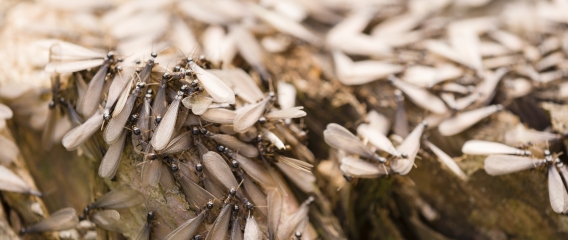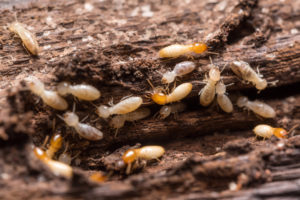Avoid the Swarm:: Termites in Missouri
Spring is here once again with blooming flowers and April showers, but not only does the rain bring in beauty but also brings in springtime termites. Spring marks the beginning of peak pest season, when most insects are coming out of their winter hiding spots, mating and in some cases finding their way into our homes. Since termites are so small and hide in the ground and in wood, they can ruin ones’ home for over a period of many years. There are home owners that have no idea that termites are eating away at their homes, so knowing the life and growth cycle of the termite can be helpful with preventing serious damage to the home.
There are more than 2,000 known termite species in the world, with at least 50 species occurring in the U.S. Termites are typically classified into three groups based on the location of the colony – subterranean, drywood and dampwood. A colony is made up of workers, soldiers and swarmers. Workers maintain the colony, construct or repair the nest, and forage for food for the colony. Soldiers are sterile, and their main role is to protect the colony. Neither workers nor soldiers have wings. Swarmers, also known as reproductives, have two pair of wings, which lie flat over the abdomen when not in use. In the springtime, after the last freeze, usually when temperatures reach about 70 degrees.The young adult male and female swarmers emerge from their nests in large groups. The female termites release ‘mating pheromones,’ much like perfume, to entice male termites. Once the male locates an alluring female, they break off their wings, symbolizing that they are a couple. The new couple then select a nest location, mate, and become king and queen of a new colony. The queen has been known to live for 30 or more years. Depending on the species, it can take three to four years before a newly founded colony reaches maturity and produce its own swarmers. In the first year, the queen can lay anywhere between 0 and 22 eggs. So at the end of the first year, a subterranean colony may contain as many as 75 individuals, whereas dry-woods may contain only a dozen. Because of this, it can take many years before a colony is large enough to cause visible damage to the wood they infest. In colder regions where termites do not typically survive the winter, new colonies can be started in one of two ways; when infested wood is introduced to a new location, or by division. Division typically occurs when a new food source is located and a sub-colony is formed to exploit the source. Eventually, this sub-colony can then produce the needed reproductives from nymphs, and completely break off as its own colony. If you notice floor damage, spongy floors, unexplained cracks on the wall, cracks on wooden beams and ceilings, misshapen door and window frames, garden damage, damaged roof tiles, hollow-sounding wood, mud tubes on exterior walls, these are all signs of termite damage and it is time to give Chiltons Pest Control a call.
Costing Americans’ an average of $5 billion dollars each year due to damage of the home, there are ways to prevent this from happening and suspecting a termite issue early on. First off, never leave firewood stacked up upon your home, this makes it easy for them to make their way into the wood and cracks. Spring is the swarming season for most subterranean termites, even though they can live throughout any season. Typically after a rainfall termites will swarm during the spring and summer months preferably on a warm day.
Having regular termite inspections done as part of regular pest control will help to spot infestation before damage is done. Having sand barriers created around the home may help to reduce termite access to the home. A good practice to create an invisible barrier around your home, meaning shrubs and plants should not be planted any closer than 18 to 24 inches from your home’s foundation. Also by having bed rock and wood chips around the home termites can be distracted and avoid the home all together. Make sure to do spring cleaning outside, pick up debris and twigs, any wet debris can rot and attract these critters.
Spring is the time to keep an eye out for termites, but even taking some of these preventive tips you still need to get yearly sprays done and Chiltons can help and allow you and your family to enjoy the Springtime without termites!




























